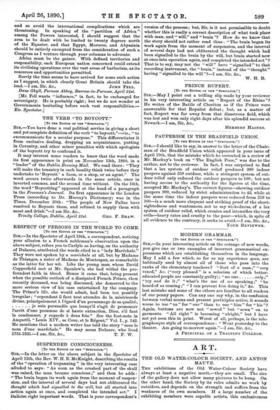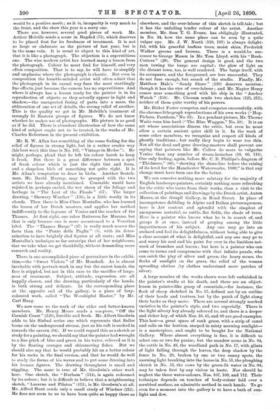ART.
THE OLD WATER-COLOUR SOCIETY, AND ANTON MAUVE.
THE exhibitions of the Old Water-Colour Society have always at least a negative merit,—they are small. The size of the gallery does not allow many pictures to be bung. On the other hand, the Society by its rules admits no work by outsiders, and depends on the strength and suffers from the weakness of its own members. If a large number of the exhibiting members were capable artists, this exclusiveness • would be a positive merit ; as it is, incapacity is very much to • the front, and the show this year is a sorry one.
There are, however, several good pieces of work. Mr. Arthur Melville sends a scene in Bagdad (75), which deserves to be placed first for its freshness of treatment. It is not so large or elaborate as the picture of last year, but is in the sanie vein. It is usual to object to this kind of art, that it is like a photograph. The objection is a superstitious one. The wise modern artist has learned many a lesson from the photograph. Colour he must find for himself, and very often composition. That is to say, he will have to simplify and emphasise where the photograph is chaotic. But even in composition the humble-minded artist will often admit that the photograph in its casual way fixes the most startlingly fine effects, just because the camera has no superstitions. And -where it always has a lesson ready for the painter is in its reproduction of objects as they actually appear in light and shadow,--the unexpected fusing of parts into a mass, the obliteration of one set of details, the strong relief of another. This is the quality we get in Mr. Melville's treatment of strongly lit Eastern groups of figures. We do not know whether he makes use of photographs. His picture is as good as if he did. There is abundant illustration of how the same kind of subject ought not to be treated, in the works of Mr. Charles Robertson in the present exhibition.
Mr. R. W. Allan has something of the same feeling for the relief of figures in strong light, but in a rather cruder way (his best work this time is No. 167, "Vintage in Medoc"). He might, perhaps, plead that he left his colour harsh to keep it fresh. But there is a great difference between a spot of fresh colour which is just the right tint and form, and a shapeless blob of something not quite right. It is Mr. Allan's temptation to draw in blobs. Another Scotch- man, Mr. David Murray, may be grouped with the two artists we have already mentioned. Constable would have rejoiced in, perhaps envied, the wet sheen of the foliage and herbage in "The Last of the Floods" (67). The larger drawing, "Showery Weather" (136), is a little woolly in its clouds. Then there is Miss Clara Montalba, who has learned the lesson of her Dutch masters, and applies her method indifferently to the lagoons of Venice and the reaches of the Thames. At first sight, one takes Battersea for Murano, but that is only because one is more accustomed to a Venetian label. The "Thames Barge" (47) is really much nearer the facts than the " Ponte della Paglia " (5), with its deter- mination to have brightly clad figures at all costs; and Miss Montalba's technique so far outstrips that of her neighbours, that we take what we get thankfully, without demanding more research and reality.
There is one accomplished piece of portraiture in the exhibi- tion,—the "Sweet Violets" of Mr. Henshall. As is almost inevitable with portrait-work in any but the surest hands, the face is stippled, but not in this case to the sacrifice of large- ness of treatment. Subject, attitude, expression, are all happily chosen, and the drawing, particularly of the hands, is both strong and delicate. In the corresponding place at the opposite end of the gallery, is a piece of foxy- coloured work, called "The Worshipful Master," by Mr. Carl Haag.
We now come to the work of the older and better-known members. Mr. Henry Moore sends a sea-piece, "Off the Cornish Coast" (120), forcible and fresh. Mr. Albert Goodwin adds to his Sinbad series one which represents that Sailor borne on the underground stream, just as his raft is sucked in towards the cavern (94). If we could regard this as a sketch or study for a painting, we should say that the painter had wrought to a fine pitch of blue and green in his water, relieved as it is by the floating oranges and shimmering fishes. But we should also say that he would probably hit on a better colour for his rocks in the final version, and that he would do well to study the forms of his waves and to put some drawing into his human figures. The drawing throughout is small and niggling. The same is true of Mr. Goodwin's other work here. One sketch, the " Durham " (114), is again redeemed • by its colour ; but it is difficult to believe that a neighbouring sketch, "Lucerne and Pilatus" (111), is Mr. G-oodwin's at all. Mr. Alfred Hunt sends only a small study of Windsor (212). He does not seem to us to have been quite so happy there as elsewhere, and the over-labour of this sketch is tell-tale; but it has the unfailing tender colour of the artist. Another member, Mr. Sam T. G. Evans, has obligingly illustrated, in No. 34, how the same place can be seen by a quite vulgar eye. Mr. J. W. North (110, 191) is always delight- ful, with his graceful leafless trees, moist skies, Frederick Walker greens and browns. There is a would-be suc- cessor to George Mason in Mr. Tom Lloyd, with his " Rush- Cutters " (29). The general design is good, and the two men towing the barge are capital ; the glow of light on the distant town, too, is well rendered. The barge itself, with its occupants, and the foreground, are less successful. They do not fuse enough, but smack of the studio. Finally, Mr. Matthew Hale's "Sandy Shore" (130) deserves mention, though it has the vice of over-labour ; and Mr. Napier Hemy comes near something good with his ship in the "Anchor Watch" (158). Mr. Clauseia sends two sketches (125, 211), neither of them quite worthy of his powers.
Mr. Birket Foster competes, and competes successfully, with the chromo-lithograph reproductions of his own works (" Hop- Pickers, Farnham," No. 63). In a pendant picture, Mr. Thorne Waite runs him hard (" The Blue Waggon," No. 59). It is an art whose associations disarm the critic, but even he must allow a certain ancient quiet skill in it. In the work of some other members, we recognise and respect all kinds of ghostly traditions ; but really they begin to wear too thin. Not all the dead and gone drawing-masters shall prevent our saying that painters like Mr. Callow do more to vulgarise Venice than any number of steam-launches (58, 66, 116), Our only feeling, again, before Mr. C. B. Phillips's diagram of " Thirlmere," (60), "showing the shore-line before the raising of its level for the Manchester Waterworks, 1889," is that any change must have been one for the better.
We can conceive nothing more salutary for the majority of English landscape-painters, certainly nothing more refreshing for the critic who turns from their works, than a visit to the collection of paintings and drawings by the Dutch artist, Anton Mauve, at the Goupil Gallery, in Bond Street. In place of incompetence dabbling in Alpine and Italian picturesqueness, here is Art content and splendid with the simplest of anonymous material, as cattle, flat fields, the shade of trees. Here is a painter who knows what he is in search of, and. grasps it at once, instead of groping among the little impertinences of his subject. Any one may go into an orchard and feel its delightfulness, without being able to give a clear account of what is delightful, and any one may go to and worry his soul and his paint for ever in the limitless net- work of branches and leaves ; but here is a painter who can come to terms and compromise with that infinite puzzle, who can catch the play of silver and green, the hoary stems, the flecks of sunlight on the grass, the relief of the woman spreading clothes (by clothes understand more patches of silver).
A large number of the works shown were left unfinished in the painter's studio at his death, and these are an object- lesson in painter-like grasp of essentials,—for instance, the- flock of sheep sketched in No. 15, defined not by an outline of their heads and trotters, but by the patch of light along their backs as they move. There are several strongly marked varieties in the painter's style, and two especially. There is thelight silvery key already referred to, and there is a deeper and richer key, of which Nos. 16,45, and 68 are good examples. This last—a great space of rank grass, with a strip of canal and sails on the horizon, steeped in misty morning sunlight— is a masterpiece, and ought to be bought for the National Gallery. Where almost everything is fine, it is difficult to select one or two for praise; but the meadow scene in No. 84, the cattle in No. 48, the woodland path in No. 17, with glints of light falling through the leaves, the deep shadow by the fence in No. 29, broken by one or two sunny spots, the morning light breaking into the house in No. 51, the ploughing sketch in No. 55, the cows by the green-lit water in No. 94, may be taken first by any visitor in haste. Nor should he neglect the three water-colours, Nos. 107, 109, and 112. Their technique depends on touches of body-colour laid over a scrubbed surface, an admirable method in such hands. To go even for a moment into the gallery is to have a bath of sun- light and dew.



































 Previous page
Previous page